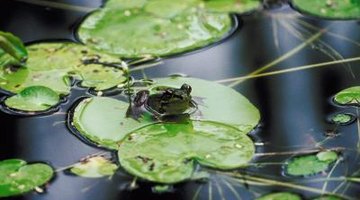How to Take Care of a Spring-Fed Pond
Spring-fed ponds are popular because they tend to offer a more natural environment with clear, constantly recycled water. Pond construction consists of damming the spring up into a pond and then constructing a spillway to allow the water to flow out at a controlled rate. Ponds are commonly utilized for flood irrigation, livestock watering, swimming, wildlife habitat and fish habitat. Pond size will often range from small or cover many acres.

Step 1
Inspect the dam and spillway for erosion or leaking every couple of weeks. Make sure rodents such as muskrats have not dug holes into the structures. Also check for beaver activity around the dam, spillway and pond.
Step 2
Remove any wood debris or other accumulation from the dam and spillway. Keep the grass mowed around the dam and spillway.
Step 3
Check the dam for any constant muddy spots or mud holes that could indicate the dam is leaking. Watch for washouts where the soil might have washed away on the dam or spillway because of a spring thaw or rainstorm.
Step 4
Check water pH monthly using a pond water pH test kit. Follow the directions on the kit, which will instruct the user how to use the kit and what to consider a healthy result from the test. A balanced pH must be maintained for fish life.
Step 5
Check the pond sides for erosion monthly or after any severe rainstorm. Erosion will cause the water to become cloudy and can pose dangerous conditions for livestock, wildlife and humans.
Step 6
Maintain grass and vegetation around the pond to prevent erosion. If grass is dying or damaged from livestock, promptly repair by replanting.
Step 7
Skim any aquatic weeds from the water every week using a skimmer. Run the skimmer across the water to scoop out the weeds.
References
Tips
- If aquatic weeds are bad along the sides of the pond consider an aquatic herbicide. Carefully follow the directions on the herbicide label. If you have fish, make sure the solution you choose is safe for fish, and if livestock drink the water, make sure it can be used safely. Herbicides should be a last resort.
- Consider draining the pond down to half the size in the wintertime by allowing more water out of the spillway to naturally control weeds instead of using a herbicide.
Warnings
- Limit direct access to the pond by livestock because their fecal matter will contaminate the pond.
- Cattle are notorious for destroying pond banks so keep cattle away from the pond.
Writer Bio
Based in Oregon, Kimberly Sharpe has been a writer since 2006. She writes for numerous online publications. Her writing has a strong focus on home improvement, gardening, parenting, pets and travel. She has traveled extensively to such places as India and Sri Lanka to widen and enhance her writing and knowledge base.
Photo Credits
- Jupiterimages/Photos.com/Getty Images
More Articles



